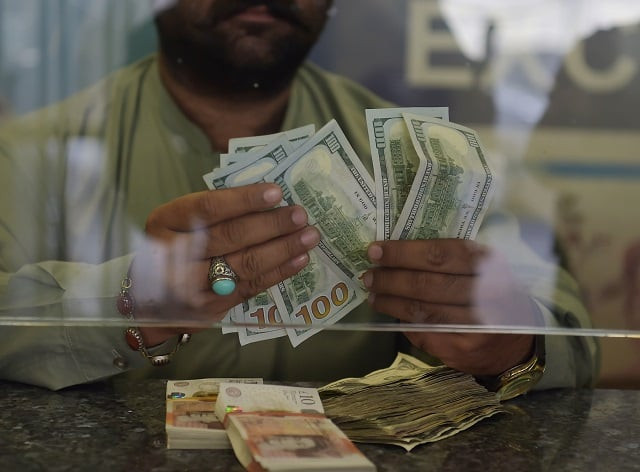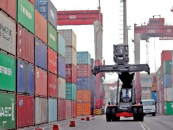Rupee touches new all-time low at 147.87 in inter-bank
Recovers from a record intra-day low of 149.55 to the dollar

Recovers from a record intra-day low of 149.55 to the dollar. PHOTO:AFP
Earlier during the day, the local currency hit a record intra-day low of 149.55 per dollar. It was the second successive day when the rupee lost ground against the greenback in a fresh round of depreciation.
Cumulatively in the past two days, the local currency weakened 4.58%, or Rs6.48, from Wednesday’s close of Rs141.39.
Adviser to Prime Minister on Finance Abdul Hafeez Shaikh said it was the State Bank of Pakistan’s (SBP) monetary policy committee which was responsible for determining the rupee-dollar exchange rate keeping in view the foreign currency demand and supply situation in the country.
In the open market, the rupee depreciated to 150.50 to the greenback, according to forex.pk.
Pakistan ponders action after rupee’s free fall
Experts said the drop in rupee’s value was expected as the government had agreed to leave the inter-bank market free from state control under the International Monetary Fund’s (IMF) 39-month loan programme worth $6 billion for Pakistan.
The government signed the loan programme on Sunday.
The IMF had asked Pakistan to let market forces decide the rupee-dollar exchange rate. Implementation of this condition was a must to convince the IMF board to give its final approval for the programme.
There was speculation in the market that the rupee may drop to 165-170 to the US dollar under the current cycle of depreciation.
Earlier, the central bank had let the rupee depreciate by a staggering 34% to 141.4 since December 2017.
“This (rupee-dollar exchange rate) movement reflects demand and supply conditions in the foreign exchange market,” said the SBP spokesman. “It (the drop in the rupee) will help in correcting market imbalances,” he added.
Forex Association of Pakistan (FAP) President Malik Bostan said the demand for dollar remained on the higher side in the inter-bank market likely due to forthcoming higher import payments and debt repayments.
He pointed out that traders usually made higher imports of raw material ahead of budget presentation in the National Assembly for the next fiscal year as the government mostly imposed new duties and taxes to meet its ambitious revenue collection target every year. “About 60% of the total imports into Pakistan comprise raw material,” he said.
Apart from that, the increase in international petroleum oil prices would also have led to increased demand for dollars as Pakistan was a net oil importer.
“Pakistan meets some 70-80% of local demand for petroleum products through imports. Oil imports come to around one-fourth of the annual import bill of Pakistan,” he said.
Moreover, some of the exporters had reportedly withheld export proceeds in anticipation of rupee depreciation as the law allowed them to receive export payments in 90 days from the date of goods’ export, he said.
A similar view came from the head of the remittances department of a state-owned bank. He said the inflow of remittances in April was lower than expected.
“The remittance inflows should be amounted to around $1.85-1.9 billion in April (compared to the $1.78 billion actually received in the month),” he said, adding that overseas Pakistanis might have withheld the remittances awaiting rupee depreciation.
Remittances for May should come close to $2 billion following the current wave of rupee fall, he said.
The remittances have remained a big source of foreign earnings for the government. They help the government in meeting foreign expenditures mainly on two counts - import payments and foreign debt repayments.



















COMMENTS
Comments are moderated and generally will be posted if they are on-topic and not abusive.
For more information, please see our Comments FAQ